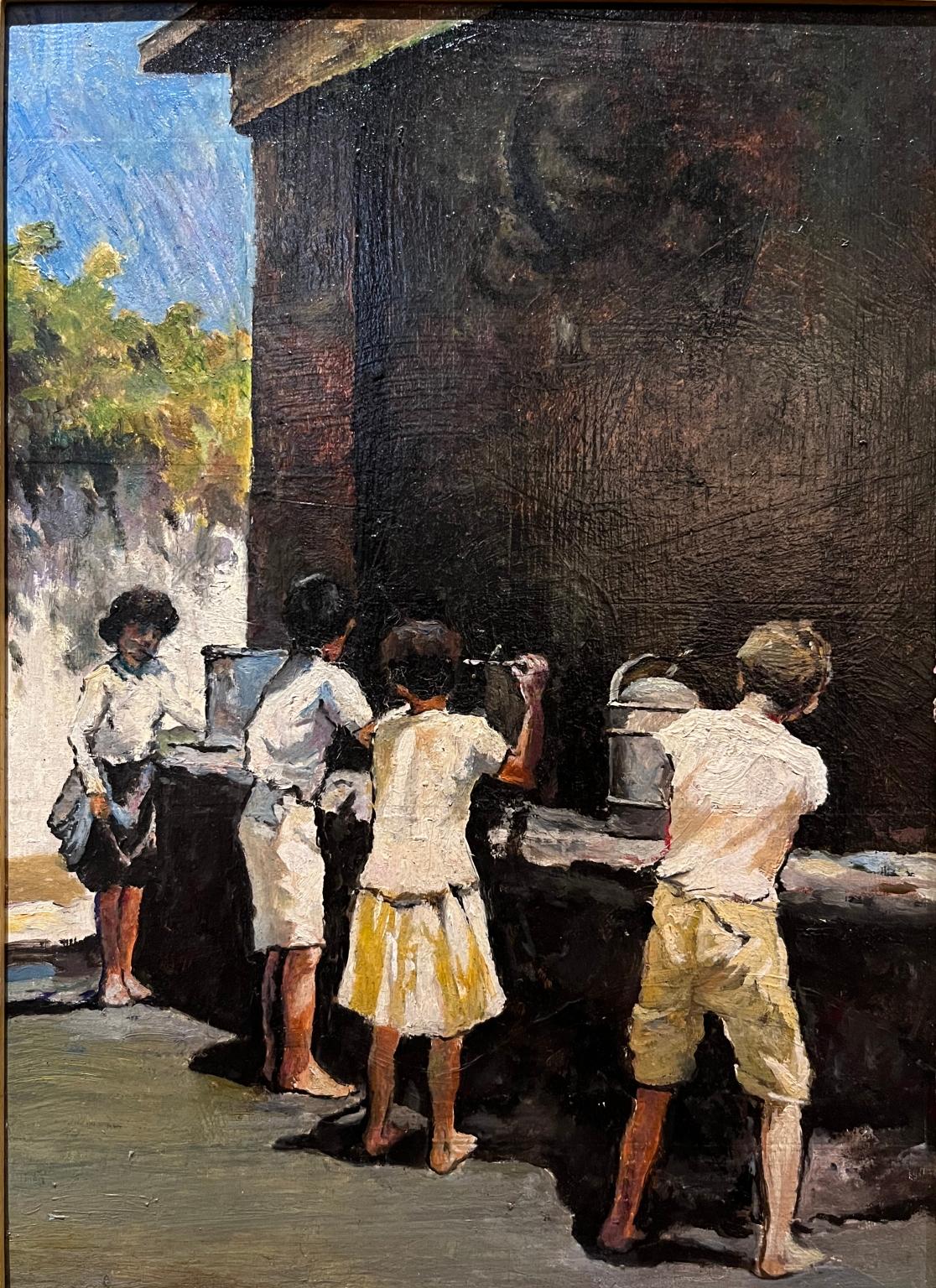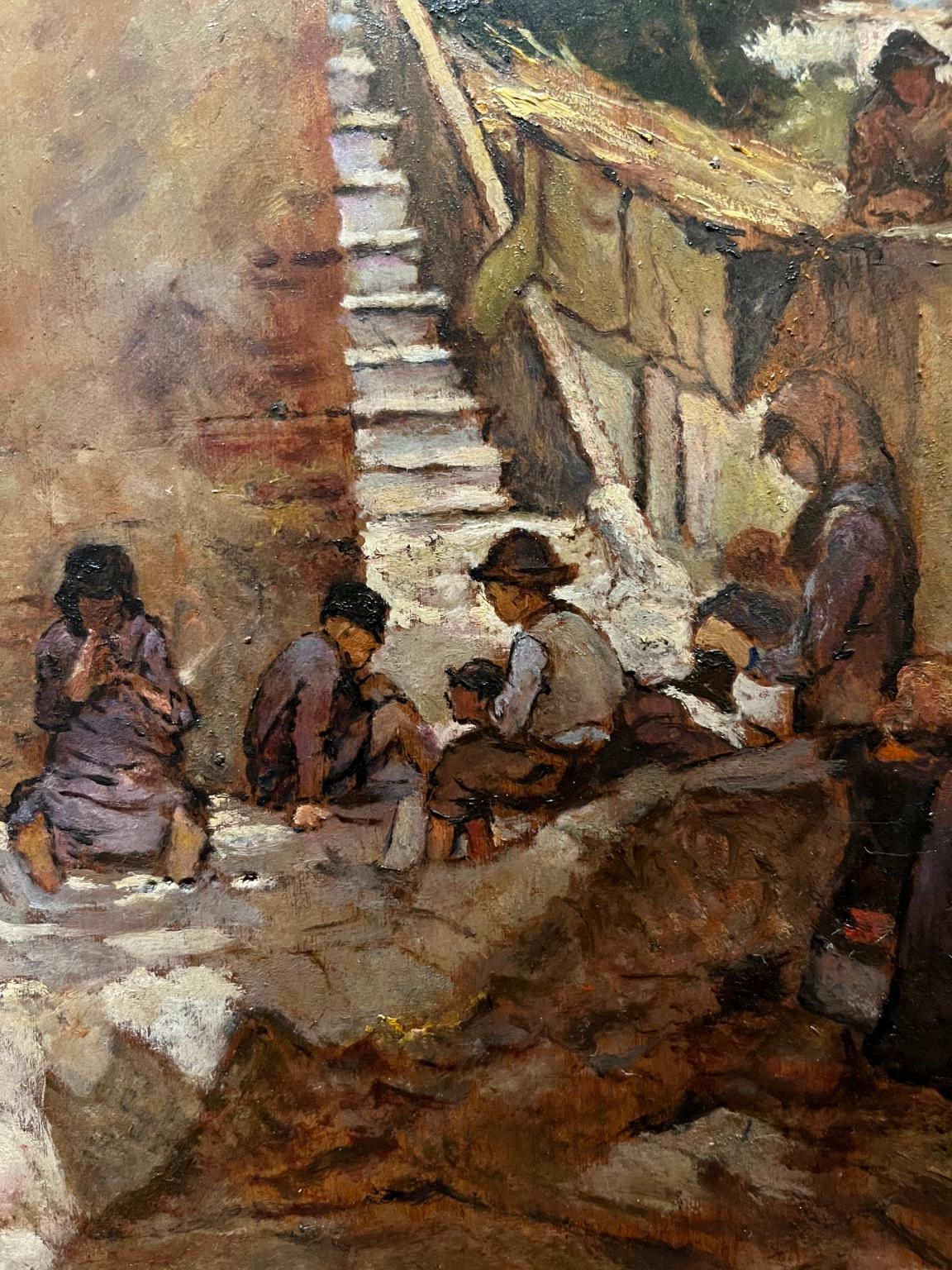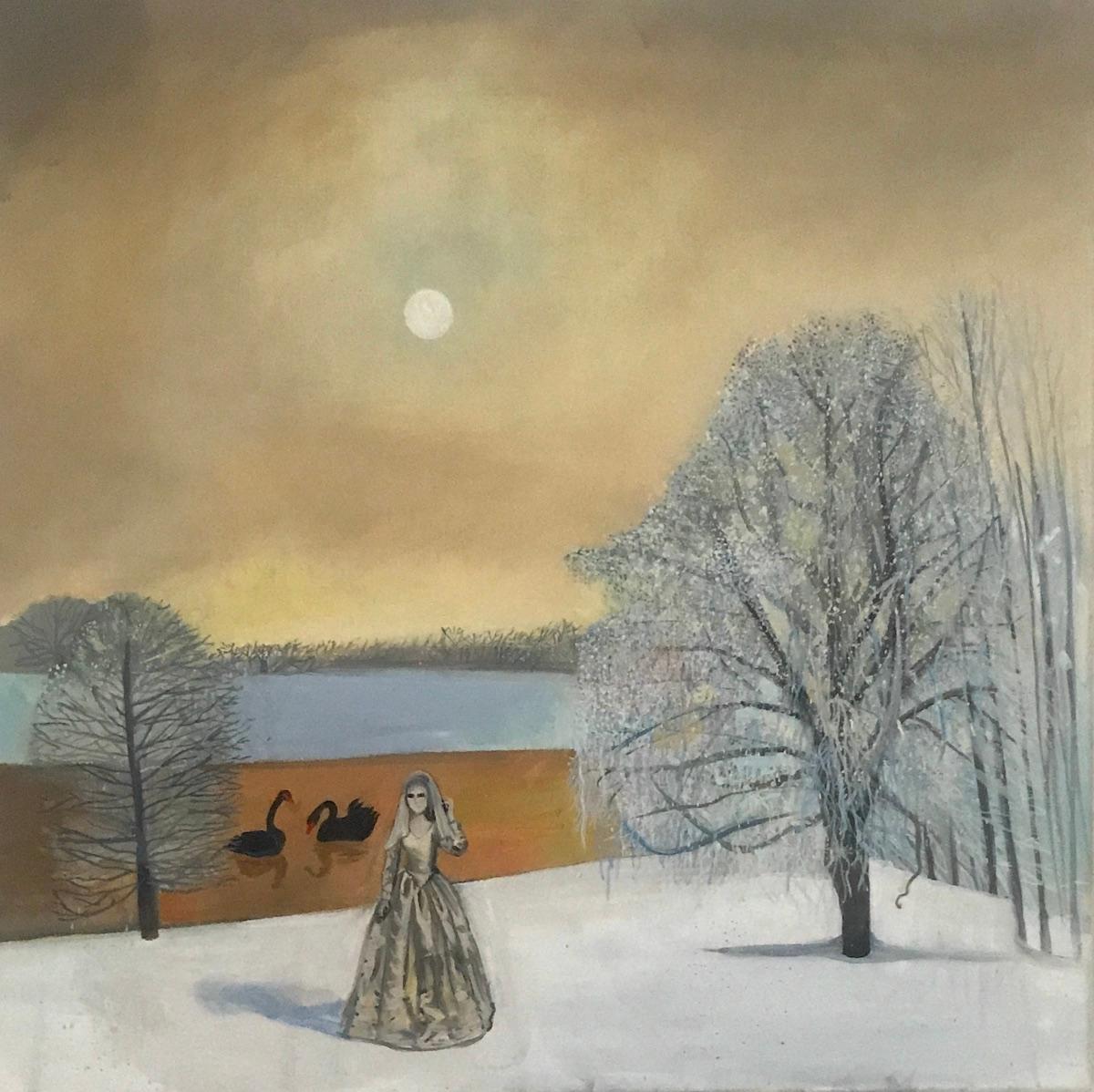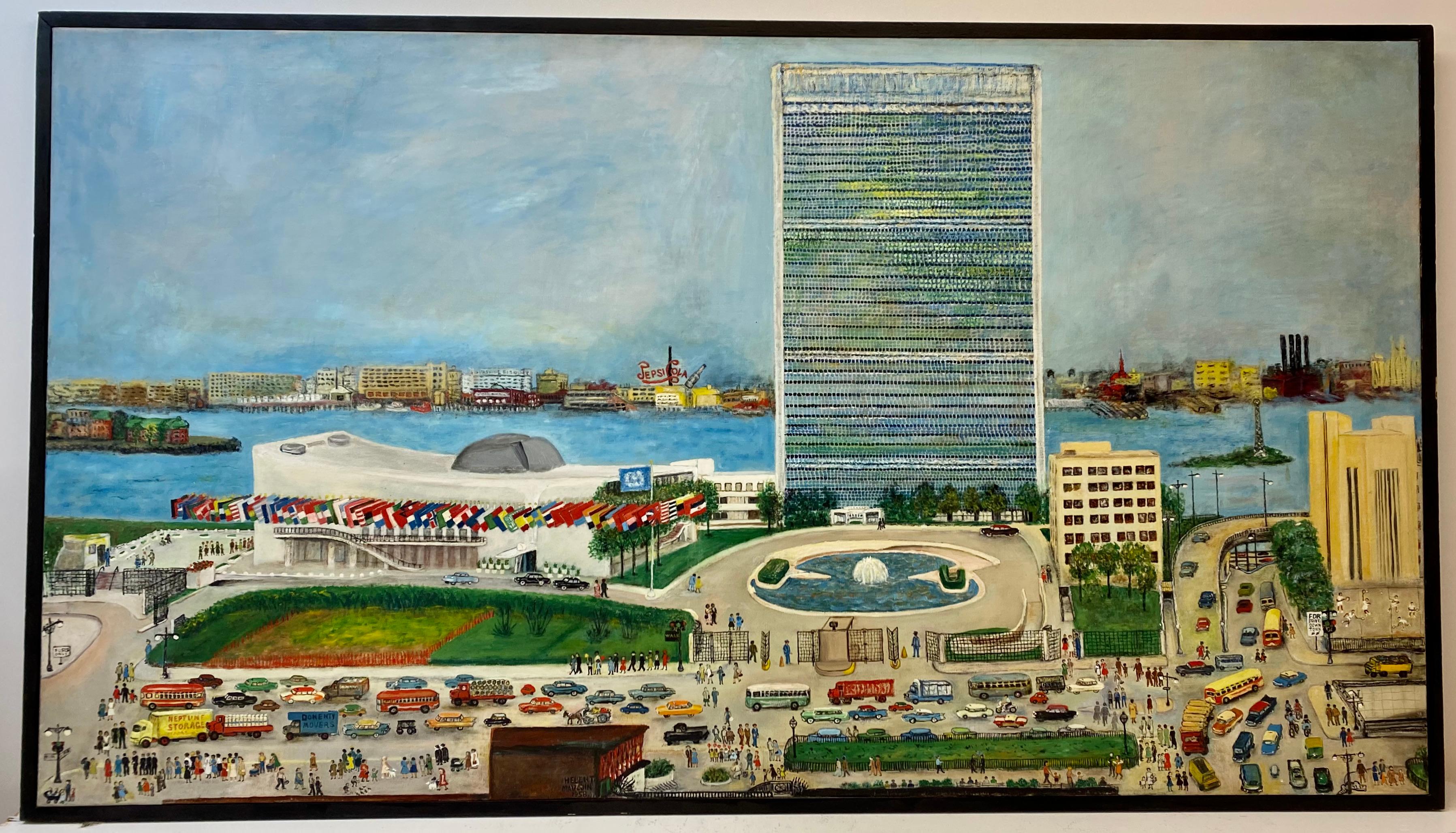Items Similar to Fantastic Village Scene Modern Irish Magic Realism Oil Painting
Want more images or videos?
Request additional images or videos from the seller
1 of 11
Philip CastleFantastic Village Scene Modern Irish Magic Realism Oil Painting
About the Item
Philip Castle was an Irish Painter and husband to artist Barry Castle
He is rarely exhibited. His detailed, meticulous work took a long time to complete and his output was quite limited.
He was the husband of Barry Castle, known for her vivid allegorical fantasies, featuring animal and human characters in stylised, often bucolic settings. Her intricately detailed work was distinguished by a note of mischievous humour but it was also thoughtful and introspective in tone. It sometimes featured self-portraits, disguised to a greater or lesser extent.
The graphic clarity and translucent colouring of her technique were ideally suited to illustration and she illustrated several books, including one, Cooking for Cats (1985), for which she herself provided the verse text. Her writing displays a mordant wit and an instinct for the macabre reminiscent of Roald Dahl.
While at the NCAD she met Philip Castle, who was studying physics at Trinity with Nobel Laureate Ernest Walton. Philip forsook his studies to become a self-taught painter of hugely detailed, architectonic compositions, and they married in 1963.
In the mid-1960s they settled in Villefranche-sur-Mer in the south of France. They subsequently acquired a ruined farmhouse in a remote part of Tuscany. Eventually managing to make a scorpion-infested section of the house habitable (formerly the pigsty, Castle maintained), they spent two months there each summer. Finding herself alone in their French home when Philip was away for a month in 1968, Castle started to paint with his brushes.
From that point on she painted consistently, though it took her some time to find her own style. Philip exhibited his work with the Portal Gallery in London and, from 1974, she showed her paintings there too. While the Portal specialised in Outsider art, she was not an Outsider artist as such. Although she described herself as a naive artist, her technique was sophisticated and displayed know-ledge of medieval and renaissance art. She also exhibited in the Solomon Gallery, Dublin.
When in Dublin she and Philip resided in a tiny building in Proud's Lane, managing to fit surprisingly large numbers of people into a minimal space for lavish dinner parties. Like her mother, she was a brilliant cook.
Reading through her mother's papers, she was inspired to illustrate some of her writings and two books ensued: The Cottage in the Bog, (1992) and The Queen of Aran's Daughter (1995), the first a story of Irish rural life, the second a collection of fairy tales set on Aran.
- Creator:Philip Castle (1942, British)
- Dimensions:Height: 21.5 in (54.61 cm)Width: 25.75 in (65.41 cm)Depth: 0.66 in (1.68 cm)
- Medium:
- Movement & Style:
- Period:
- Condition:
- Gallery Location:Surfside, FL
- Reference Number:1stDibs: LU38211256732
About the Seller
4.9
Platinum Seller
These expertly vetted sellers are 1stDibs' most experienced sellers and are rated highest by our customers.
Established in 1995
1stDibs seller since 2014
1,539 sales on 1stDibs
Typical response time: 1 hour
- ShippingRetrieving quote...Ships From: Surfside, FL
- Return PolicyA return for this item may be initiated within 3 days of delivery.
More From This SellerView All
- French Folk Art Naive Oil Painting Workers in Vineyard, Les Vignes aux GitansLocated in Surfside, FLMax Savy Oil on canvas painting depicting a village scene with winemakers in a vineyard by artist Max Savy (French, b. 1918). Signed in the lower right. Frame measures 24.5 inches x 28 inches. canvas is 18 X 22 inches., Perfect for a wine cellar or cave. Max Savy (French, 1918-2010) painted scenes of everyday life in the French Corbieres region, which garnered much success during his life. Though the artist remained silent about his early life, it's known his father instilled in him a belief in the humanist socialism philosophy of French Socialist Party leader, Jean Jaures. In 1938, at age 20, he moved to Carcassonne to attend school. There, he married and settled into a teaching position, joining the French Resistance during World War II and earning the Cross of the Combatant. After the war, he created the work for which he is most admired. Max Savy paintings are part of France's heritage collection, and the artist became a knight of the National Order of Merit in 1973. Max Savy's paintings and artworks include scenes of peasants in the fields. Max Savy was active/lived in France. Max Savy is known for folk art style painting of village architecture, vintners, figures in landscape, wine makers, marine scenes. His work is similar in style to the naive, folk art paintings of Michel Delacroix and Fanch Ledan. This is quite similar to a work I had titled "Les Vignes Aux Gitans" (the gypsy grape vines) So i assume this is also a vineyard painting...Category
Mid-20th Century Folk Art Landscape Paintings
MaterialsCanvas, Oil
- Naive London Street Scene Folk Art Oil Painting Big Ben, Parliament, Union JackBy Andrew MurrayLocated in Surfside, FLBig Ben, House of Parliament with Union Jack flag, Thames River, boats, barges, airplane and double decker red bus. Classic London street scene. 24 inches by 11 inches in a frame 24.5 inches by 11.5 inches. ANDREW MURRAY became known and loved as an imaginative Naive painter who captured the character of cities (especially Cape Town and London) with humorous and affectionate insight. An English counterpart to Michel Delacroix of Paris and Charles Fazzino of New York He was born in north China, the son of a missionary. As a child of five he had his first lesson in painting from the son of another, the 10-year- old Mervyn Peake...Category
20th Century Folk Art Figurative Paintings
MaterialsCanvas, Oil
- Magic Realist Surrealist Latin American Naive Fantasy PaintingBy German Ramon Duron LanzaLocated in Surfside, FLMagic realist fantasy painting in the manner of Ernst Fuchs and Arik Brauer. Naïve art is any form of visual art that is created by a person who lacks the formal education and training that a professional artist undergoes (in anatomy, art history, technique, perspective, ways of seeing). Unlike folk art, naïve art does not necessarily evince a distinct cultural context or tradition. Naïve art is recognized, and often imitated, for its childlike simplicity and frankness. Paintings of this kind typically have a flat rendering style with a rudimentary expression of perspective. One particularly influential painter of "naïve art" was Henri Rousseau (1844–1910), a French Post-Impressionist who was discovered by Pablo Picasso. Naïve art is often seen as outsider art that is by someone without formal (or little) training or degree. While this was true before the twentieth century, there are now academies for naïve art. Naïve art is now a fully recognized art genre, represented in art galleries worldwide. Museums devoted to naïve art now exist in Kecskemét, Hungary; Riga, Latvia; Jaen, Spain; Rio de Janeiro, Brasil; Vicq France and Paris. "Primitive art" is another term often applied to art by those without formal training, but is historically more often applied to work from certain cultures that have been judged socially or technologically "primitive" by Western academia, such as Native American, sub saharan African or Pacific Island art (see Tribal art). This is distinguished from the self-conscious, "primitive" inspired movement primitivism. Another term related to (but not completely synonymous with) naïve art is folk art. There also exist the terms "naïvism" and "primitivism" which are usually applied to professional painters working in the style of naïve art (like Paul Gauguin, Mikhail Larionov, Paul Klee). At all events, naive art can be regarded as having occupied an "official" position in the annals of twentieth-century art since - at the very latest - the publication of the Der Blaue Reiter, an almanac in 1912. Wassily Kandinsky and Franz Marc, who brought out the almanac, presented 6 reproductions of paintings by le Douanier' Rousseau (Henri Rousseau), comparing them with other pictorial examples. However, most experts agree that the year that naive art was "discovered" was 1885, when the painter Paul Signac became aware of the talents of Henri Rousseau and set about organizing exhibitions of his work in a number of prestigious galleries. The Earth Group (Grupa Zemlja) were Croatian artists, architects and intellectuals active in Zagreb from 1929 to 1935. The group included the painters Krsto Hegedušić, Edo Kovačević, Omer Mujadžić, Kamilo Ružička, Ivan Tabaković, and Oton Postružnik, the sculptors Antun Augustinčić, Frano Kršinić, and the architect Drago Ibler. A term applied to Yugoslav (Croatian) naive painters working in or around the village of Hlebine, near the Hungarian border, from about 1930. Some of the best known naive artists are Dragan Gaži, Ivan Generalić, Josip Generalić, Krsto Hegedušić, Mijo Kovačić, Ivan Lacković-Croata, Franjo Mraz, Ivan Večenaj and Mirko Virius. Camille Bombois (1883–1970) Ferdinand Cheval, known as 'le facteur Cheval' (1836–1924) Henry Darger (1892–1973) L. S. Lowry (1887–1976) Grandma Moses, Anna Mary Robertson (1860–1961) Nikifor (1895–1968) Poland, Horace Pippin (1888–1946) Jon Serl (1894-1993) United States Alfred Wallis (1855–1942) Scottie Wilson (1890–1972) Gesner Abelard (b. 1922) Jan Balet (1913–2009) Michel Delacroix (b. 1933) France Howard Finster (1916–2001) Ivan Rabuzin (1921–2008) Spontaneous Art Museum in Brussels Art en Marge Museum in Brussels MADmusée in Liege International Museum of Naive Art of Brazil in Cosme Velho, Rio de Janeiro Gallery Jacques Ardies in São Paulo Musée international d'art naïf de Magog in Magog Croatian Museum of Naïve Art in Zagreb Gallery of Croatian Naïve Art...Category
20th Century Folk Art Figurative Paintings
MaterialsCanvas, Acrylic
- Large Israeli Naive Art Screen Enamel Oil Painting Jerusalem Old City Folk ArtBy Gabriel CohenLocated in Surfside, FLJERUSALEM, Vielle du David, (City of David) Superlac (enamel) painting on paper, hand signed, titled and dated. Provenance: Michael Hittleman Gallery Los Angeles. Gabriel Cohen, (French-Israeli) Self taught, Naive painter was born in Paris in 1933, to parents from Jerusalem with a father who studied the kabbalah. Throughout World War II, the family hid from the Nazis in Paris. Images of Nazi soldiers appear in several of his paintings. In 1949, when Gabriel was 16, the family returned to Israel. They managed to save enough money to move back to the quarter where both parents were born: Ohel Moshe in Nachlaot. Gabriel served in the artillery corps and after the army, went back to live in his parents' house and earned a living polishing diamonds. The head of the polishing plant, who noticed his employee's artistic skill, allowed him to paint during work hours. He once asked Cohen if he could draw a tiger. Cohen drew him a tiger. And he did a lot of sculpting and painting on glass. He also loved to play the guitar, especially flamenco style. Critics say he is one of Israel's greatest naive-style painters. Along with Shalom of Safed, Kopel Gurwin and Natan Heber, He is renowned as one of Israel's greatest living naive-style folk art painters, recipient of the Jerusalem Prize for Art (1987), a permanent entry in encyclopedias of naive painting, who exhibited his work not only in Israel, but also in Paris, Venezuela, Denmark and Germany; the same Gabriel Cohen whose colorful , bold Naif paintings were exhibited at the Jewish Museum in New York in 1987 alongside works by Marc Chagall; the same Gabriel Cohen about whom curator and art scholar Gideon Ofrat says, "There is no questioning his greatness." He has shown in Paris on the Rue de Rosiers in the Marais. His impressions of his journeys, mostly imaginary, yet some real, are expressed in Cohen's paintings. Huge, colorful canvases rich in precise detail and fantasy, in which he paints the Eiffel Tower and the Russian steppes or the vistas of Paris and the Tower of Babel "In my opinion, it's also because the Tower of Babel has some kind of phallic, erotic meaning, but also because of the internationalism, of the mixture and confusion of nations, which is an essential element in Gabi Cohen's work," says Gideon Ofrat. There is no superlative that has not been lavished on Cohen's work by art critics, since he began showing his paintings at age 40, All the art critics seemed to agree at once that Cohen is one of the greatest naive-style painters in Israel. Their counterparts abroad seconded this view. About a year and a half ago, Zadka organized a show for Cohen at the Jerusalem Artists' House. The Tel Aviv Museum bought a painting of Gabi's and so did the Israel Museum, and several artists bought his drawings. He is a great, great painter. There is no painter who is more of a symbolist and illustrative artist than he is. As a painter myself, I admire him." The Yom Kippur War in 1973 sparked an artistic breakthrough for Cohen; it was at that time that he began to sit on the sidewalk after his work as a diamond polisher and paint. Not long afterward, in early 1974, he did a painting he called "Moses on the Mountain." Ruth Debel, of the Debel Gallery in Ein Kerem, passed by and saw it on the street. She asked how much he wanted for it, and for the first time in his life, he realized that his work had financial value. His first show was at the Debel Gallery in 1974. The response was overwhelming. Cohen was immediately declared a genius. His paintings at the gallery were purchased and he continued to create new paintings. That same year, he was invited to take part in a group exhibition of naive artists at the Kunsthaus in Zurich, and a year later, his work was included in a traveling show of naive-style artists from Israel that was exhibited in Denmark and Germany. Soon after that he was invited to be part of group shows in Venezuela and at the Tel Aviv Museum. Cohen had four solo shows at the Debel Gallery. Awards And Prizes 1987 Jerusalem Prize for Painting and Sculpture 1999 Shoshana Ish-Shalom Prize for special contribution to art, Jerusalem He has exhibited alongside all of the Israeli great artists. included in the Naive Art Group exhibition Gvanim Art Gallery, Jerusalem Rubin, Rachel Roman, Yitzhak Zarembo, Leah Moscovitz, Shalom (of Safed) Steinberg, Michael Denisov, Salva Harbon, Haim Cohen, Gabriel Chanannia, Joseph (Jojo) Local Hero...Category
20th Century Folk Art Landscape Paintings
MaterialsPaper, Oil, Alkyd
- King David, Jerusalem (after Marc Chagall) Oil Painting Israeli Judaica ArtBy Zammy SteynovitzLocated in Surfside, FLFramed 41.5 x 29.5 image 35.5 x 23.5 This large painting depicts a man and woman, Adam and Eve, interlocked and embracing one another. The woman holds an enticing apple as they are thrusted from the Garden of Eden. This is an original painting. Zamy Steynovitz was born in Liegnitz Poland, in 1951. He immigrated to Israel in 1957. The aspiration to be a painter stems from his childhood and before leaving Poland, he won the first prize in an art competition for children. Zamy was formally educated at the Art School in Tel-Aviv and at the Royal Academy of London. Upon completing his studies, Zamy earnestly pursued his career and establish his place in the art world by displaying his work in one man exhibits and arts fairs around the world. His art displays chromatic and thematic richness and his choice of subjects has been strongly influenced by Jewish tradition, his Eastern European Jewish heritage and folklore. Zamy’s popular themes include Paris cafes, still-life, flowers, circuses and landscapes. Circus with acrobats and Harlequin. In the early stages of his career, he was partial to rich pastels and light brush strokes. In the early 1980s, Zamy visited South America, where the new surroundings enhanced his work with local brightness and color. His art gained chromatic power and his palette became richer in tones as the textures became thicker and the background darker and more colorful. These changes coupled with his thematic persistence allowed him to develop into a sensitive and mature artist. Zamy expresses a universal humanistic vision in his creations: man’s connection to his heritage and physical surroundings, two imperative aspects of our lives that should be heralded during these estranged technological times. As a result of his devotion to world peace, Zamy is known in the circles of the Nobel Institute for Peace in Norway. He is acquainted with many Nobel Prize winners including Anwar Sadat, Menachem Begin, the Dalai Lama, Itzhak Rabin, Shimon Peres, Elie Wiesel, Desmond Tutu and Oscar Arias, the ex-President of Costa Rica, along with many other politicians and artists. Zamy tragically passed away in September 2000. Exhibitions One Man Show 1970 - Museum - Ramat - Gan 1973 - Brussels - Gallery L'Angle Aigu 1974 - London - International Gallery 1974 - Paris - Grand Palais Gallery 1975 - Milan - Brera Gallery 1976 - N.Y. Valentino Gallery - N.Y. Hilton 1977 - N.Y. Valentino Gallery - N.Y. Hilton 1978 - Basel - Actual Gallery 1978 - Geneve - Bohren Gallery 1978 - Oslo - Nobel Peace Prize Exhibit 1979 - London - Hamilton Gallery 1979 - N.Y. - Art Israel Kalt - Waldinger Gallery 1979 - N.Y. - Canty Art Gallery 1979 - Amsterdam - Schipper Gallery 1979 - Washington - International Art Fair 1980 - Cleveland -Jewish Museum 1980 - Tel-Aviv - Habima National Art Fair 1981 - Abraham - Goodman House N.Y. 1981 - San Lucas Galley - Bogota 1982 - Pedro Gerson Gallery - Mexico City 1983 - Simon Bolivar...Category
20th Century Modern Figurative Paintings
MaterialsCanvas, Oil
- Austrian Magic Realist Oil Painting Vibrant Village Landscape Scene Franz CoufalLocated in Surfside, FLFramed 24.5 x 28.5 image 19.5 x 23 inches. Franz Anton Coufal (Austrian, 1927 - 1999) Painter and sculptor known for figure painting, bronze sculpture, genre paintings and as a graphic artist. After completing an apprenticeship as a locksmith, Franz Anton Coufal attended the Graphic Education and Research Institute in Vienna from 1947 to 1949 as a student of André Roder and from 1949 to 1953 took lessons from Ignaz Schönbrunner. From 1953 to 1959 he finally studied with Fritz Wotruba at the Academy of Fine Arts (diploma and master school award 1959). Coufal then went on study trips to Germany and Italy and then settled in Vienna as a sculptor and graphic artist. His work bears the influence of Austrian Magic Realism and the artists Friedensreich Hundertwasser, Arik Erich Brauer and Ernst Fuchs. THis work also has Expressionist elements to it. He organized exhibitions in Vienna (from 1955), Paris (1962, 1970) and Brussels (1964) as well as in other Austrian cities. His most important works include the honorary grave for Leopold Figl in the central cemetery (1966). In 1979 he provided the design for the face of the silver 100 schilling coin "Festival and Congress House Bregenz", in 1980 he created the Lehár monument for the city park, and in 1987 he received the special prize in the "Danube Region Vienna" competition. A select list of his sculptures in public spaces "Standing youth" (19, Hameaustraße - Celtesgasse, urban residential complex; 1960) "Reclining youth" (22, Kagran [Meißnergasse - Maißauer Gasse - Anton-Sattler-Gasse]; artificial stone, 1962) "Flammender Turm" (16, Thaliastraße 159; marble) Cubist marble sculpture (11, Molitorgasse at 15) Drinking fountain (20, Adalbert-Stifter-Straße primary school; 1968) Figldenkmal (1, Minoritenplatz, 1973) Coufal created some of his later works for the "Harmonie" rest home for the blind in Unterdambach near Neulengbach (memorial for the 144 blind people who perished in concentration camps, unveiled in 2000; stone sculpture "Monument to Humanity" on the terrace; rose-thorn cross and tabernacle for the in-house Odilien- Chapel; bronze portrait sculpture by Robert Vogel in the entrance hall, unveiled July 3, 1994). Bibliography Rudolf Schmidt: Austrian artist lexicon. From the beginning to the present. Vienna: Tusch 1974-1980 Who's Who in the world. Volume 2: 1974-1975. New Providence, NJ: Marquis Who's Who 1974 Who's who in the world. Volume 3: 1976-1977. New Providence, NJ: Marquis Who's Who 1976 Who is Who in Austria with South Tyrol part (Hübner's "Blue Who is Who"). Zug: Who is who, Verlag für Personalenzyklopädien 12 1995 Otto Breicha: Franz Anton Coufal In: Franz Anton Coufal. Österreichische Staatsdruckerei, December 9-22, 1964. Vienna: Staatsdruckerei 1964 The press, July 30, 1963 Of the generation of Viennese artists Alois Mosbacher, Josef Mikl, Oswald Oberhuber, Christian Ludwig Attersee, Peter Sengl, Max Weiler, Franz Ringel, Gunter Brus, Hubert Schmalix, Wilhelm Kaufmann, Paul Flora, Oscar Larsen, Hans Staudacher, Siegfried Anzinger, Ernst Huber...Category
20th Century Modern Landscape Paintings
MaterialsOil, Canvas
You May Also Like
- "Once Upon a Time" Mid Century Figurative LandscapeLocated in Soquel, CACharming mid-century naive painting of small figures and chickens in a rural landscape by an unknown artist (American, 20th Century). Signed with the monogram "I. M. H." on lower lef...Category
1960s Folk Art Landscape Paintings
MaterialsCanvas, Oil, Cardboard
- Tuscan Figurative Genre Scene painting 20th century oil on canvasLocated in Florence, ITThe artist of this painting is unknown but it can be ascribe to a Tuscan movement of the 20th century inspired by 19th century art like Verismo (as we can deduce by the clean and not...Category
20th Century Folk Art Figurative Paintings
MaterialsCanvas, Oil
- Tuscan Figurative Genre Scene painting 20th century oil on canvasLocated in Florence, ITThe artist of this painting is unknown but it can be ascribe to a Tuscan movement of the 20th century inspired by 19th century art like Verismo (as we can deduce by the clean and not...Category
20th Century Folk Art Figurative Paintings
MaterialsCanvas, Oil
- Black Swan, Daisy Clarke, Contemporary Painting, Figurative art, Landscape artLocated in Deddington, GBBlack Swan by Daisy Clarke Original and hand signed by the artist Oil on Board Image size: H:60cm x W:60cm Complete size of unframed work: H:60cm x W:60cm x D:2.5 Sold unframed Ple...Category
21st Century and Contemporary Folk Art Landscape Paintings
MaterialsCanvas, Oil
- Helen Mauldin New York City "United Nations" Large Scale Folk Art Painting 1958Located in San Francisco, CALarge Scale New York City "United Nations" Folk Art Painting by Helen Mauldin c.1958 Fine mid century primitive outsider folk art painting of an aerial view of United Nations Plaza in New York City looking towards Long Island City, in the New York City borough of Queens. There is so much color and detail in this painting. Hundreds of people from school children, groups of people playing tennis, bus drivers, policemen, pedestrians, etc., all out on a beautiful blue sky day. There is a lot happening in this painting; you're sure to see something different every time you look at it. The painting is very large and is painted on canvas. Signed by the outsider artist Helen T...Category
Mid-20th Century Folk Art Landscape Paintings
MaterialsCanvas, Oil
- Parked Cars: Modern, Naive Style Square Oil Painting of Cars in a Gray LotBy Darshan RussellLocated in Hudson, NYOil on board 19 x 19 inches in dark brown wood frame 18 x 18 inches unframed This modern, abstracted naive style oil painting was made by Poughkeepsie, NY based artist Darshan Russe...Category
2010s Folk Art Landscape Paintings
MaterialsCanvas, Oil
Recently Viewed
View AllMore Ways To Browse
From A Castle
Village Oil Painting
French Village Painting
Paintings Of Ireland
Ireland And Painting
Magic Set
Village Scene Art
Painting Of A Castle
Fantastic Landscape
French Castle
Artist From Ireland
Renaissance Style Painting
Vintage Castle
Irish Modern
Philip Collection
Minimal Modern Painting
Large Modern Graphic Art
Ireland Landscape





